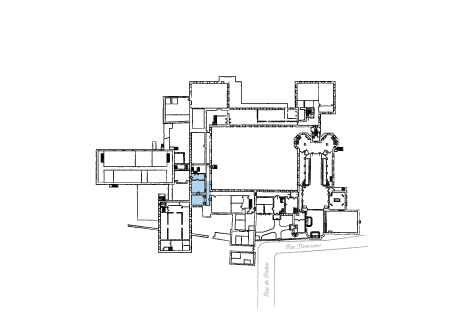0:00 - 0:09
We are in the center of the Monastery. To our right is the St. Augustin staircase. We will come back.
0:09 - 0:13
We go straight ahead.
0:13 - 0:18
We take the right corridor. The first door on the right leads to the archives.
0:18 - 0:21
We enter this area with multiple vocations.
0:21 - 0:24
Take a look to the right. Let's observe the room.
0:24 - 0:35
Stop our movement in front of the fireplace. It is said that it is by the light of this fireplace that Mary of the Incarnation did all her writing.
0:35 - 0:51
We’ll now look up at the painting of the first Monastery. It has been copied many times from the original drawing made from memory by one of the nuns.
0:51 - 0:53
Continue the tour of the room by turning to the left.
0:53 - 1:00
In front of us is one of the doors of the museum and archives of 1942.
1:00 - 1:12
We continue our tour on the left. We pass a large wooden door leading to the archive research room. And we return to the exit.
1:12 - 1:20
We take the corridor to the right. Continue straight ahead.
1:20 - 1:26
To the right is the entrance to the first chapel, also called the original chapel.
1:26 - 1:41
We enter and advance towards a small commemorative altar. It is here that the Holy Canadian Martyrs celebrated Mass at the beginning of the colony.
1:41 - 1:53
We proceed slowly on our right to quickly see the portrait of Madame de la Peltrie, the benefactor of the first Ursulines.
1:53 - 2:00
We stop our movement in front of the door that once led to the private part of this chapel. This door was then an iron gate.
2:00 - 2:08
We continue, turning to the right.
2:08 - 2:24
On our left is the portrait of Mother St. Joseph. We stand facing the exit. The dates marked on the ground are commemorative.
2:24 - 2:29
We turn again to the right.
2:29 - 2:42
We observe the portrait of Mary of the Incarnation, the foundress of this monastery and of the Canadian Union.
2:42 - 2:51
We turn left, and take the corridor towards the exit.
2:51 - 3:10
We take the small staircase on the right leading to the Parlor wing. This area is not level, because it was built on Cape Diamond, a hard rock impossible to even out at the time.
3:10 - 3:17
Take few seconds to observe around us.
3:17 - 3:25
We stop at the convent door, which is normally closed. And turn right to the entrance hall of the Monastery.
3:25 - 3:48
It is through here that visitors usually enter. We say goodbye to you now. But don’t forget that you have plenty of places to visit.












